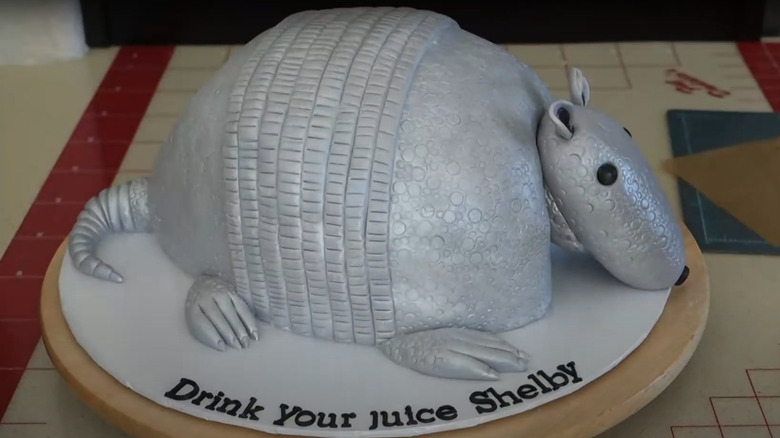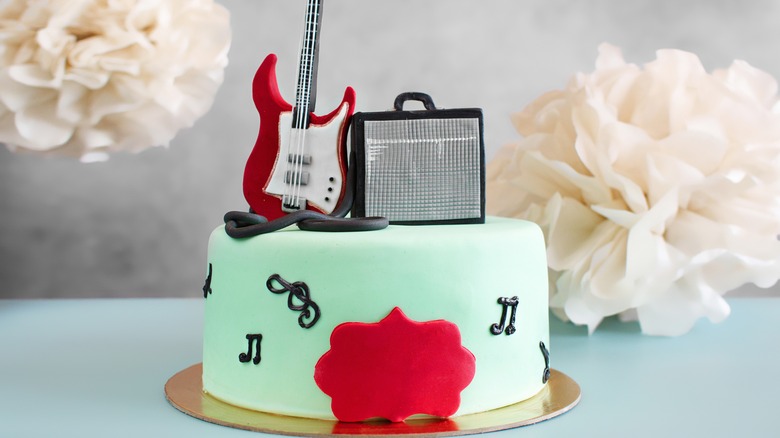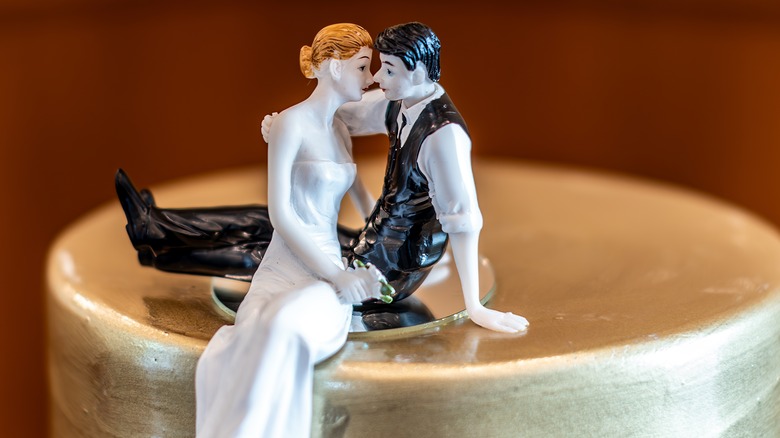What Are Armadillo Cakes And Are They Still A Thing?
We may receive a commission on purchases made from links.
Newlyweds cutting and eating a wedding cake together is a longstanding tradition, but did you know that it's considered a bride's cake? Many couples think that it's only fair for the groom to get his own too, which is where an armadillo cake comes into play.
You have the 1989 film "Steel Magnolias" to thank for the armadillo cake's popularity. Until this movie was released, the groom's cake was largely a Southern tradition in the States. Jackson, the groom in the film played by Dylan McDermott, wants a red velvet cake shaped like an armadillo because it's his aunt's specialty. The scene featuring the dessert is hilariously memorable because Shelby, the bride played by Julia Roberts, remarks, "Worse, the cake part is red velvet cake. Blood red. People are gonna be hacking into this poor animal that looks like it's bleeding to death" (via Amazon Prime).
Even now, armadillo groom's cakes are set out at wedding receptions across the country. Some professional and at-home bakers have found ways to make red velvet cake without using dye (for anyone who might be worried about the ingredients that make up artificial coloring) and have even taken the bleeding concept further by filling and decorating the cakes with red fruit, fruit-based jams or jellies, and candies.
The origins and popularity of the groom's cake
Although wedding cakes have unexpectedly ancient origins, groom's cakes originated in the late 1800s. Then, it was commonplace for there to be three cakes at weddings — a large cake for the guests, a small cake for the bridesmaids, and another small cake for the groomsmen. This groom's cake was typically a heavy fruitcake that was laced with alcohol. This practice followed English colonists as they moved to the American South, but it has since changed a little over the years.
Today, the groom's cake is usually made with bolder flavors (like chocolate and, of course, red velvet) than the main showstopper — though it's still possibly infused with liquor — and shaped and decorated to demonstrate the groom's personality. Some couples get really creative with cakes that look like a nostalgic food or dish, sights from a city that's important to the groom, a favorite sports team theme (think a stadium, jersey, or even sports equipment), or a depiction from a movie scene (as in the case of the armadillo cake). It's a fun way for the bride to celebrate the groom on their special day.
Wedding cake superstition and customs
There are many superstitions surrounding weddings, and British and American customs have mixed and influenced each other over centuries. One of these involves unmarried women finding husbands with the help of a groom's cake.
For the custom, someone would cut the cake into slices and place them in individual boxes that were passed out to the unmarried female guests. The women would sleep with their slices of cake under their pillows. It was said that they would dream of their future husbands or that the practice would bring them good luck in finding a spouse.
Another superstition involves topping wedding cakes with figurines similar to the wedding couples to manifest stability in their marriages. This custom started as a simple representation of the couple when Queen Victoria used mini sculptures for her wedding cake in 1840. Toppers became a stylish addition by the 1890s and, like the groom's cake, eventually found their way to the United States in the 1920s. Even giant general stores like Sears had wedding cake toppers pages in their catalogs.
As the practice became prominent in the 1950s after World War II, it morphed into a symbol of the couple's stability. While that particular symbolism has been largely lost and generic toppers are common today, it's not uncommon for brides and grooms to opt to design their own to represent something special to them.



